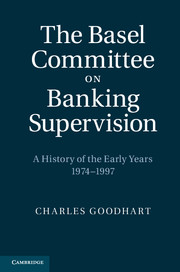Book contents
- Frontmatter
- Contents
- Figures
- Tables
- Foreword
- Preface
- 1 Introduction
- 2 The antecedents of the BCBS
- 3 Modus operandi
- 4 The Concordat
- 5 External and foreign exchange issues
- 6 Capital adequacy and the Basel Accord of 1988
- 7 The Market Risk Amendment
- 8 The Core Principles of Banking Supervision
- 9 Liquidity
- 10 Off-balance-sheet exposures and derivatives
- 11 Other topics addressed by the BCBS
- 12 The relationship of the BCBS with banks and other banking regulators
- 13 Relationships with other non-bank oversight and supervisory bodies
- 14 The legal position of the BCBS
- 15 The international relations of the BCBS
- 16 The BCBS and the social sciences
- 17 Epilogue
- Bibliography
- Index
6 - Capital adequacy and the Basel Accord of 1988
Published online by Cambridge University Press: 07 September 2011
- Frontmatter
- Contents
- Figures
- Tables
- Foreword
- Preface
- 1 Introduction
- 2 The antecedents of the BCBS
- 3 Modus operandi
- 4 The Concordat
- 5 External and foreign exchange issues
- 6 Capital adequacy and the Basel Accord of 1988
- 7 The Market Risk Amendment
- 8 The Core Principles of Banking Supervision
- 9 Liquidity
- 10 Off-balance-sheet exposures and derivatives
- 11 Other topics addressed by the BCBS
- 12 The relationship of the BCBS with banks and other banking regulators
- 13 Relationships with other non-bank oversight and supervisory bodies
- 14 The legal position of the BCBS
- 15 The international relations of the BCBS
- 16 The BCBS and the social sciences
- 17 Epilogue
- Bibliography
- Index
Summary
Early work
The very first papers that were circulated to the BCBS (in response to a letter from Rene Larre, the then General Manager of the BIS, in 1974) concerned the ‘Rules and practices to protect the banks’ solvency and liquidity’, notably included a report by several countries of their capital adequacy requirements. The methodology of such requirements varied considerably between countries, with Continental European countries tending to require risk-weighted ratios and the Anglo-Saxon countries having no formal ratio at all. It may be helpful, if only as an aide-memoire, to recall what the diversity of requirements was at the start of 1975, and the page from the Secretariat’s Summary on this is reproduced as Appendix A to this chapter.
In these early years, there were two main topics relating to capital that were discussed. The first was whether or not, and subject to what restrictions, subordinated debt could be used as part of capital for capital adequacy purposes; there was a wide range of answers, all the way from not at all in Germany, to up to 50% in Luxembourg and 40% in Denmark. The second was how far foreign bank branches, as contrasted with subsidiaries, should also have their own endowment, or dotation, of capital. This latter issue would seem to muddy the distinction between branch and subsidiary, and to be inconsistent with the legal convention that foreign branches formed an integral part of the domestic bank. Nevertheless, at this time several Continental countries did require such a dotation before authorising branches of foreign banks in their own countries. Although there was a description of countries’ differing approaches to subordinated debt, there was no attempt to come to a view on best practice, let alone to suggest a harmonised approach.
- Type
- Chapter
- Information
- The Basel Committee on Banking SupervisionA History of the Early Years 1974–1997, pp. 146 - 223Publisher: Cambridge University PressPrint publication year: 2011
- 25
- Cited by



